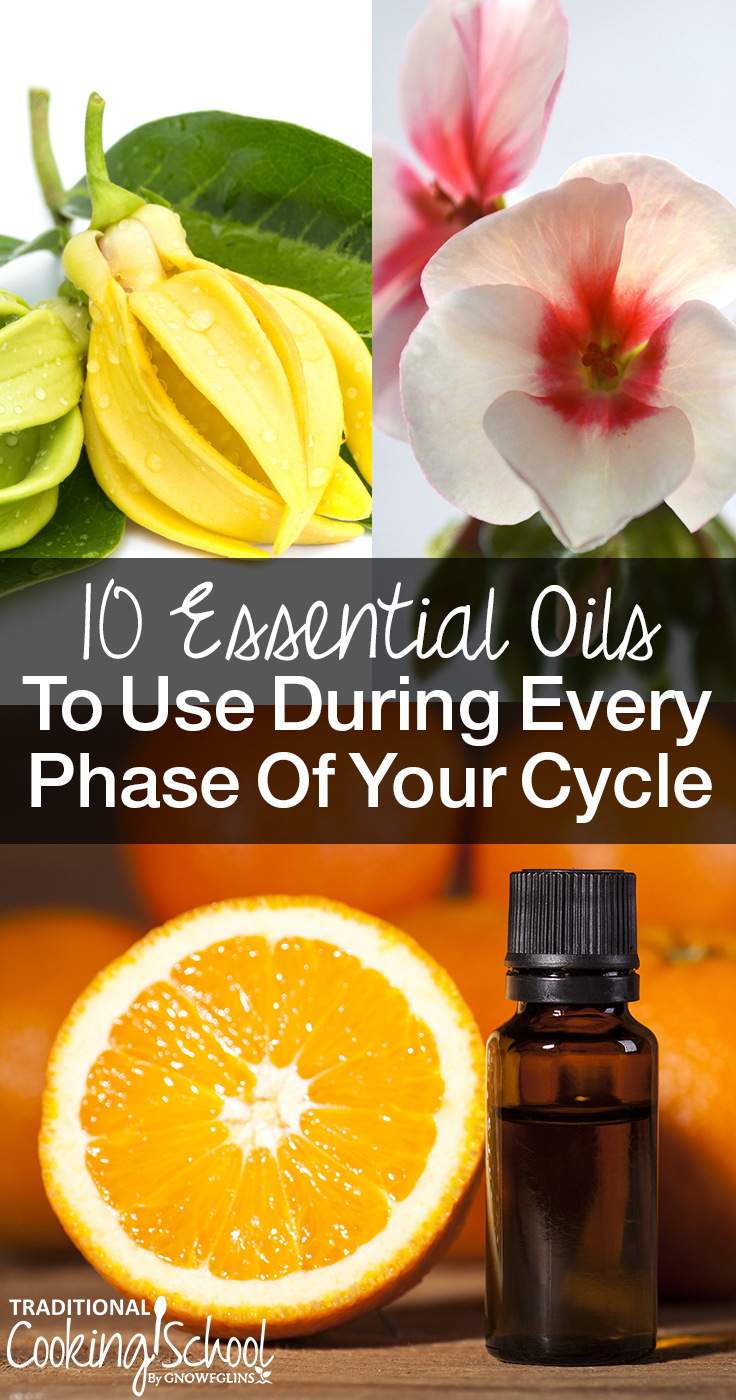
Headaches, cramps, bloating…
Confidence, focus, energy…
Women run the gamut of weird, cycle-related symptoms! Can you relate? Have you felt on top of the world one day, only to sink into an unproductive, unmotivated slump the next?
With the slow return of my fertility after pregnancy, I’m starting to feel the natural ebb and flow of my hormones once again. Hormones are complex, intricate, beautiful things that affect women’s health like nothing else. The female cycle will always have highs and lows, yet certain essential oils can step in to restore balance if necessary and keep everything running smoothly.
Which essential oils? Good question! Let’s begin!
First, A Word On Using Essential Oils Safely
The key to safely using essential oils is dilution. I’m currently breastfeeding, and I plan to do so for a while yet, so I follow aromatherapist Eric Zielinski’s advice to use a 1% dilution of essential oils while pregnant or breastfeeding. This means…
- 6 to 8 drops of essential oils per ounce of carrier oil, OR
- 3 drops of essential oils per 10 mL bottle of carrier oil.
If you’d like to find a dilution rate that works for you, here’s a helpful chart. The Complete Book of Essential Oils and Aromatherapy, 2nd edition, also contains a dilution chart starting on page 14.
Can Essential Oils Act Like Or Balance Hormones In The Body?
The short answer? Yes and no.
Certain essential oils, such as clary sage, are sometimes said to have estrogenic properties. In other words, they act like estrogen in the body. If true, this could potentially be beneficial for times of the female cycle when we want to promote estrogen’s effects (such as during the follicular phase — more info below). However, clary sage isn’t estrogenic (that’s an internet myth!). And there isn’t enough research to say whether other essential oils are, either. (Source and source.)
Eric Zielinski does point out that it may be possible for essential oils to indirectly cause the release of hormones in the body. This would occur when an essential oil stimulates an endocrine gland in such a way that it releases one or more of its hormones. (Source).
Additionally, some essential oils, such as geranium, do seem to have a hormone-balancing effect in the body (source).
Yet, much of this is still conjecture, so let’s explore what evidence there is to be found and hold our conclusions loosely until there’s more information! Regardless of their effects on hormones, essential oils are certainly still helpful during the highs and lows of the female cycle.
The Two Phases Of The Female Cycle
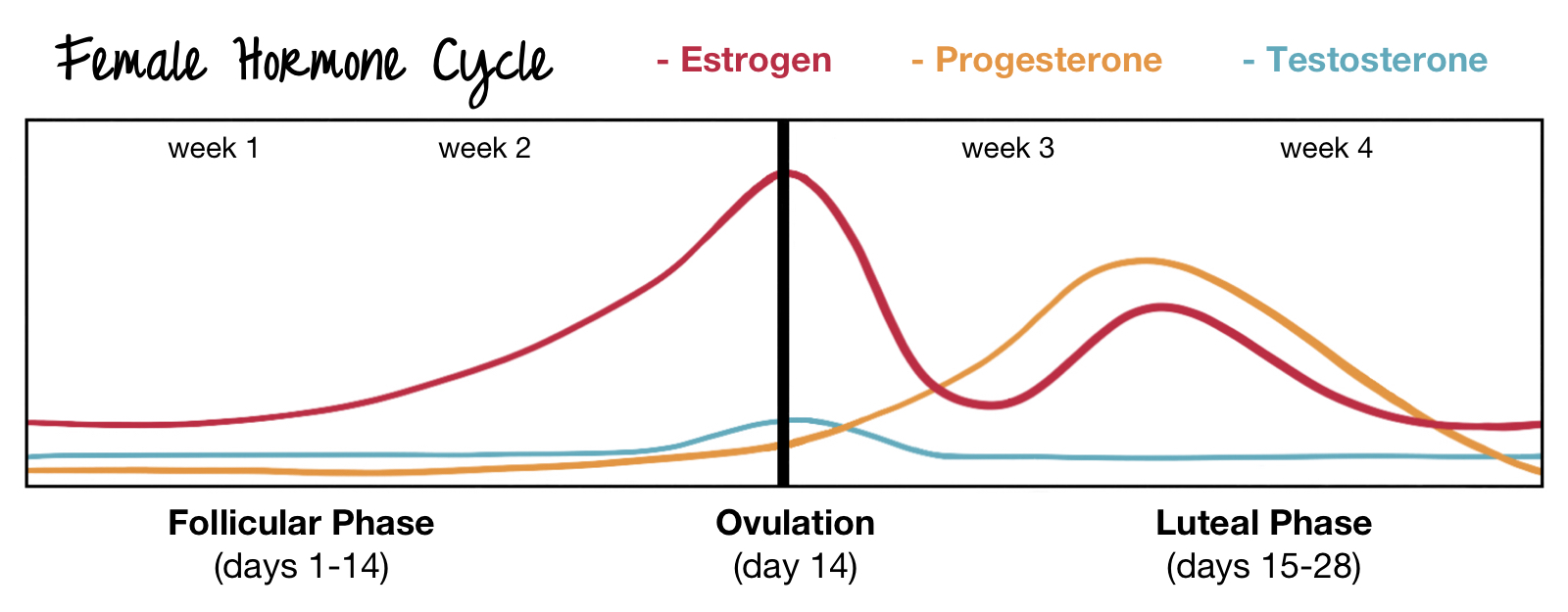
There are two phases in every menstrual cycle:
- first, the follicular phase
- followed by the luteal phase
Assuming a 28-day cycle, the follicular phase lasts from onset of menses to the day before ovulation (days 1 to 14). It is so named for the maturation of ovarian follicles, one of which releases an egg during ovulation. Estrogen is the dominant hormone during the follicular phase.
The luteal phase lasts from ovulation to the day before bleeding begins again (days 15 to 28). It is named for the corpus luteum, the ruptured ovarian follicle left behind after ovulation which produces hormones in preparation for pregnancy. If pregnancy does not occur, the corpus luteum degrades after about 10 days, leaving a scar on the ovary called a corpus albicans. Progesterone is the dominant hormone during the luteal phase.
10 Essential Oils To Use During Every Phase Of Your Cycle
Now that we’ve laid the foundation of essential oil safety and what exactly happens in your body every month, let’s talk about each of the 10 essential oils to use during your cycle, followed by when it’s most helpful to use them!
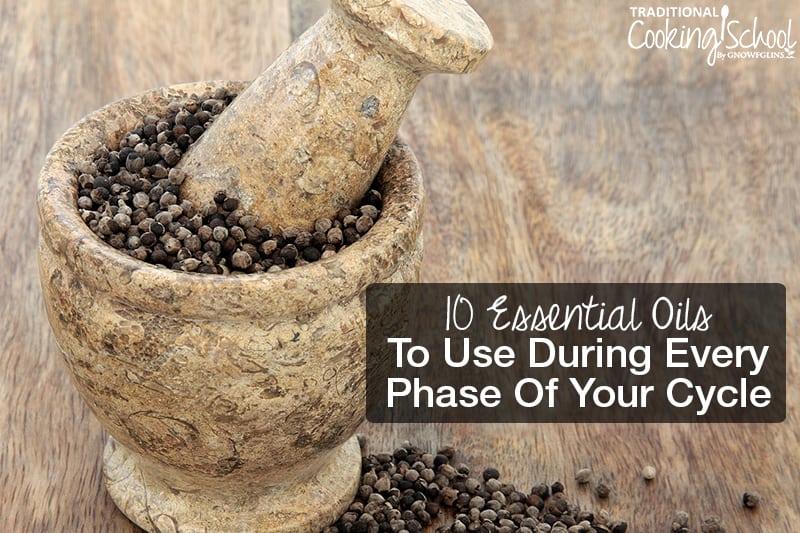
#1 — Vitex Berry (Vitex agnus castus)
Also known as Chasteberry, Abraham’s Balm, and Monk’s Pepper.
Contrary to its name, vitex berry essential oil is actually derived from the leaf of the Vitex agnus castus plant! While there aren’t many studies on the efficacy of the essential oil, the herb has traditionally been used to help regulate women’s cycles.
It reportedly does this by ensuring that the pituitary gland produces ample luteinizing hormone for ovulation, progesterone production, and a healthy luteal phase. By promoting progesterone production, it helps the body maintain a normal ratio between estrogen and progesterone. Additionally, vitex berry essential oil may ease perimenopause, boost fertility, clear hormonal acne, and alleviate PMS. (Source and source.)
While essential oils don’t always have the same healing properties as their respective herbs, evidence supports the fact that vitex berry essential oil may benefit women in these ways, too (source).
To use: Dilute with a carrier oil (such as fractionated coconut oil or jojoba oil) and apply topically in a roll-on or massage oil. It blends well with other essential oils such as geranium, lavender, and ylang ylang.
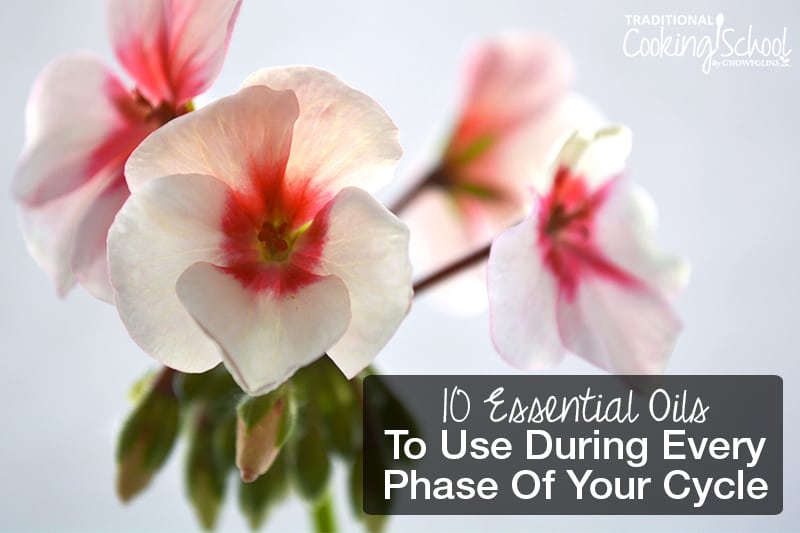
#2 — Geranium (Pelargonium graveolens)
Also known as Sweet Scented Geranium and Old Fashioned Geranium.
This essential oil, with its pleasing flowery aroma, may help balance hormone levels. Ovulation in particular depends on adequate hormone levels — specifically luteinizing hormone. This oil also boosts the mood and alleviates mood swings. (Source.)
Finally, if your monthly cycle takes a toll on your skin, geranium can help! It is both healing and a natural astringent which means it tightens wrinkles, prevents sagging, and even causes scars to fade more quickly (source).
To use: Diffuse to boost your mood or apply topically, diluted with a carrier oil (such as fractionated coconut oil or jojoba oil). Feel free to add geranium to any of your DIY lotions and potions — perhaps a face serum or perfume. Geranium blends well with essential oils like lavender and orange.
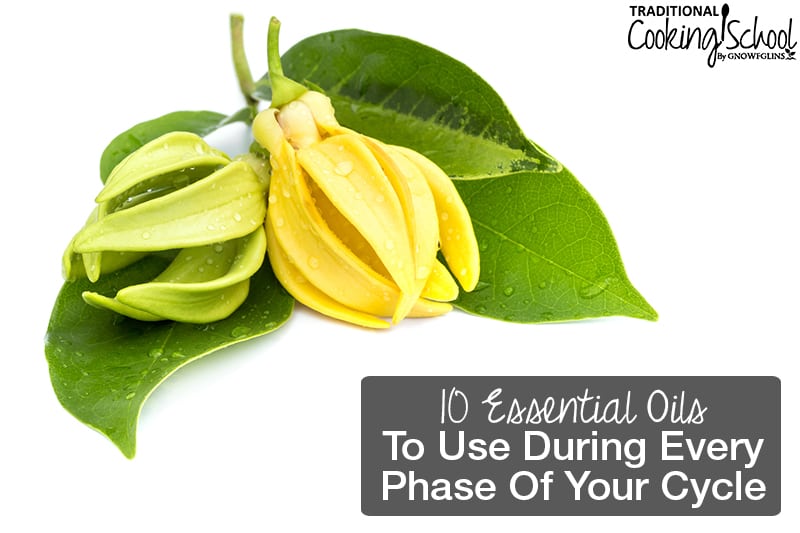
#3 — Ylang Ylang (Cananga odorata)
Also known as Massacar.
Traditionally used as an aphrodisiac, this essential oil is calming and anti-inflammatory — perfect for the aches and pains of a particularly unpleasant period! It often boosts libido as it relieves stress and anxiety, which means this oil has a place in your essential oil repertoire no matter the time of month. (Source.)
To use: Since ylang ylang has a strong aroma, blend with other essential oils such as geranium, lavender, and orange. It works wonderfully added to a massage oil or roll-on. You can also diffuse it in the bedroom to set the mood or relax before bed!
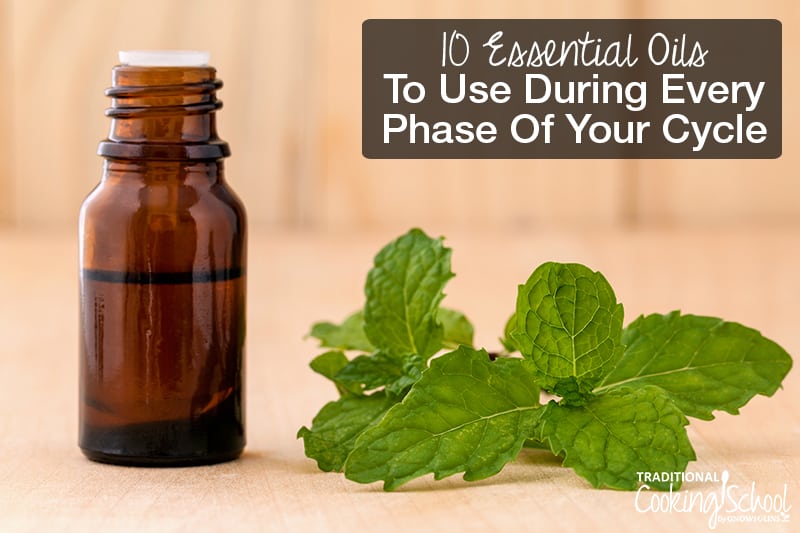
#4 — Peppermint (Mentha x piperita)
All hail the mighty peppermint — the essential oil that puts “pep” in your step! 😉 It relieves pain, whether that be a tension headache or cramp, and its energizing power can get you through any afternoon PMS slump (source).
To use: Combine with a carrier oil (such as fractionated coconut oil or jojoba oil) to a roll-on and apply to your stomach and the small of your back when experiencing cramps — like this No More Cramps! Essential Oil Roll-On. Or, diffuse! Peppermint blends well with lavender, orange, and rosemary.
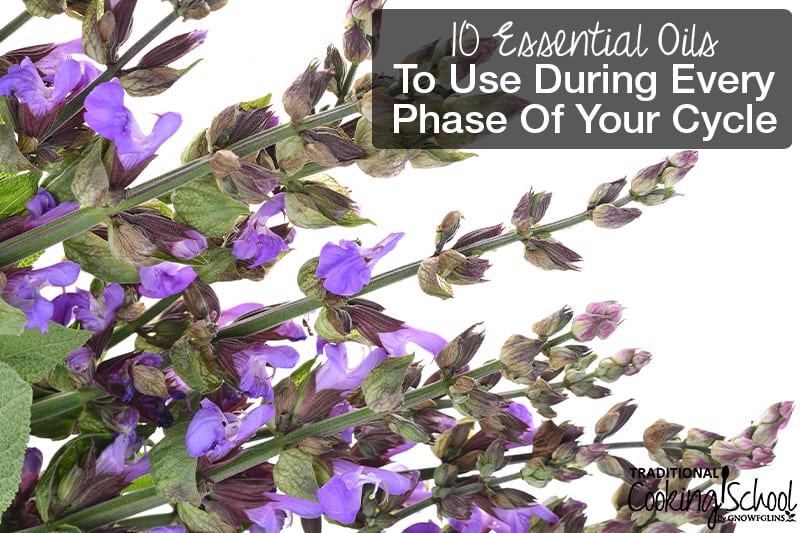
#5 — Clary Sage (Salvia sclarea)
Also known as Clary and Clear Eye.
When combined with sweet marjoram and lavender, clary sage has been shown to be even more effective than Tylenol at relieving pre-menstrual and menstrual cramps (source). If you’re a member of Traditional Cooking School, be sure to check out Lesson 6 of our Women’s Health eCourse for an essential oil roll-on using these oils.
Clary sage also helps balance hormones by reducing cortisol levels, meaning that it de-stresses, relaxes, and calms (source). Many women actually use it for pain relief and relaxation during labor — that’s how effective it is!
To use: Use diluted with a carrier oil (such as fractionated coconut oil or jojoba oil) in a roll-on with sweet marjoram and lavender for period cramps. Simply apply wherever it is painful. Clary sage also blends well with geranium, vitex berry, and ylang ylang.
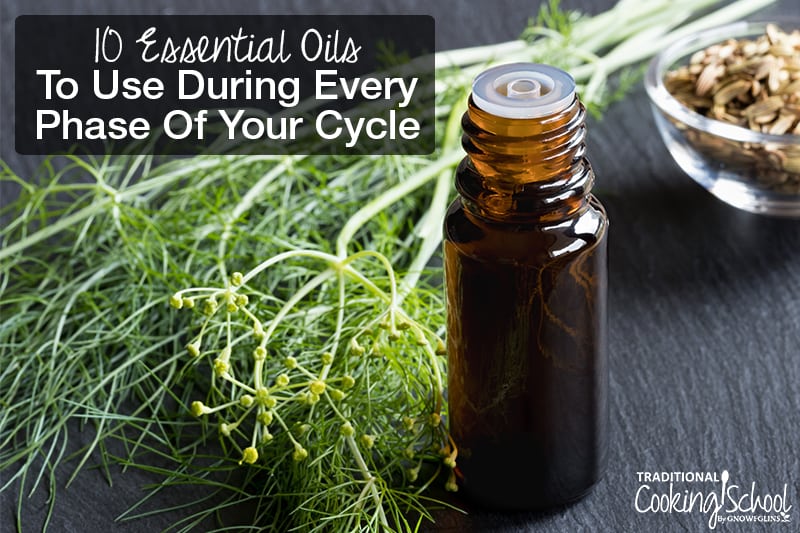
#6 — Fennel (Foeniculum vulgare)
Also known as Finule.
Fennel essential oil decreases the frequency and intensity of menstrual cramps. If you’re a breastfeeding mama like me, you’ll also be pleased to know that it increases breast milk production in many women! Finally, it boosts digestion. I think we can all relate to feeling a little sluggish and bloated at certain times of the month! (Source.)
To use: Dilute with a carrier oil (such as fractionated coconut oil or jojoba oil) and massage into the stomach area. It has a strong peppery, licorice-like aroma, so you may prefer to blend it with oils such as lavender or orange.
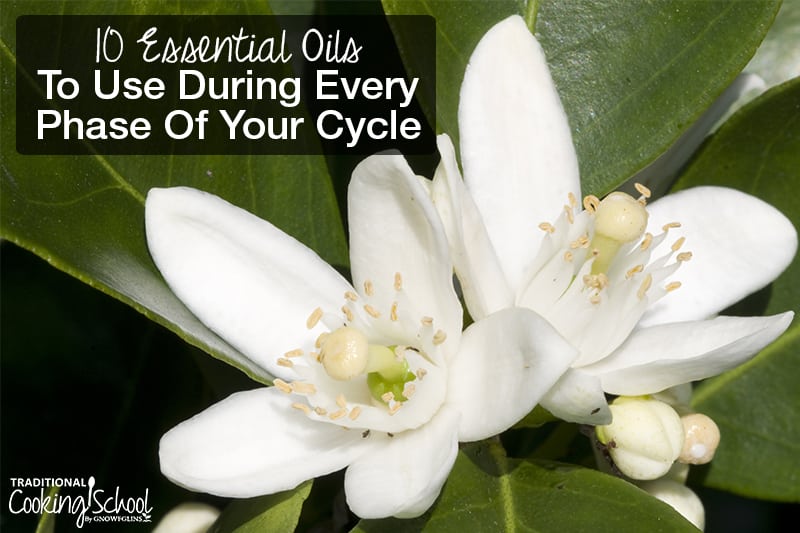
#7 — Neroli (Citrus x aurantium)
Also known as Orange Blossom, Bitter Orange, and Sour Orange.
Certainly one of the more expensive oils, neroli is worth the cost! It lessens pain and studies have shown it to be effective at relieving hot flashes in menopausal women (source). It is anti-inflammatory and helps balance hormones by reducing cortisol, a stress hormone.
To use: Add to a massage oil or perfume, diffuse, or add a few drops to a bath for a relaxing soak! Neroli blends well with geranium, lavender, and ylang ylang.
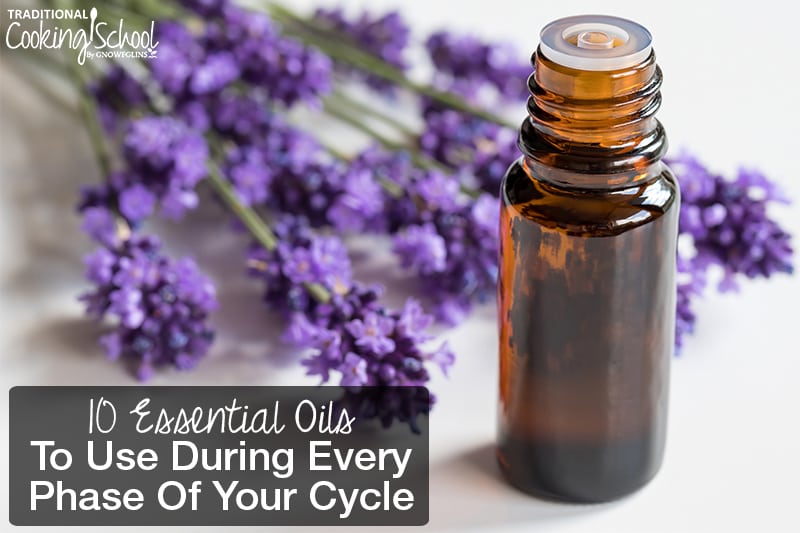
#8 — Lavender (Lavandula angustifolia)
Also known as English Lavender, Garden Lavender, Common Lavender, True Lavender, and Narrow-Leaved Lavender.
If you’re hit with insomnia at any point in your cycle, reach for lavender! It promotes sleep and relaxation while boosting one’s mood (source). Lavender is also antimicrobial, which makes it a powerful ally against common female issues like bacterial vaginosis or yeast infections (source).
To use: Diffuse to relax before bed. Add diluted to a roll-on and apply to temples for gentle soothing. You can even apply highly diluted lavender essential oil vaginally to relieve pathogen overgrowth. Lavender blends well with geranium, orange, and ylang ylang.
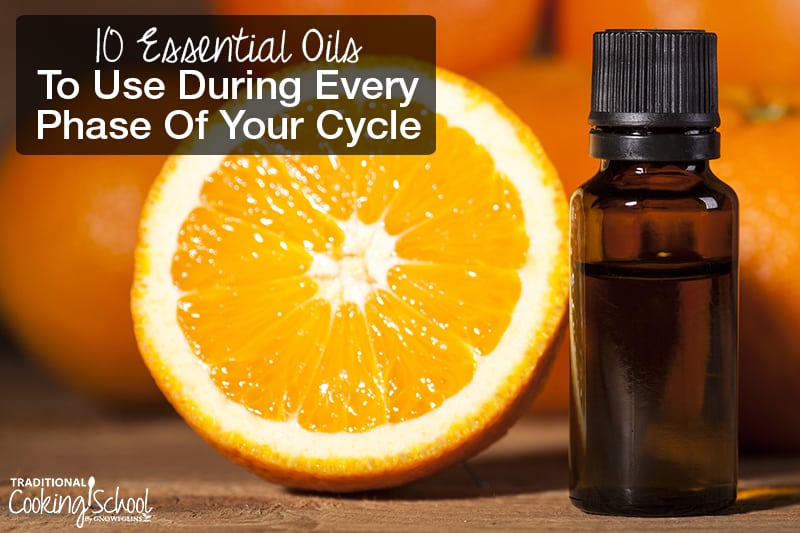
#9 — Orange (Citrus sinensis)
Also known as Sweet Orange.
Orange essential oil, like all of the other citrus oils, boosts the mood and provides an immediate burst of energy (source)! This makes it the perfect choice for combating any depression, even including postpartum depression.
To use: Diffuse, diffuse, diffuse! Since orange and many other citrus oils are phototoxic, avoid topical application if going out into the sun within 12 hours, or apply to areas of the skin covered by clothing. Orange blends well with grapefruit, lemon, and sandalwood.
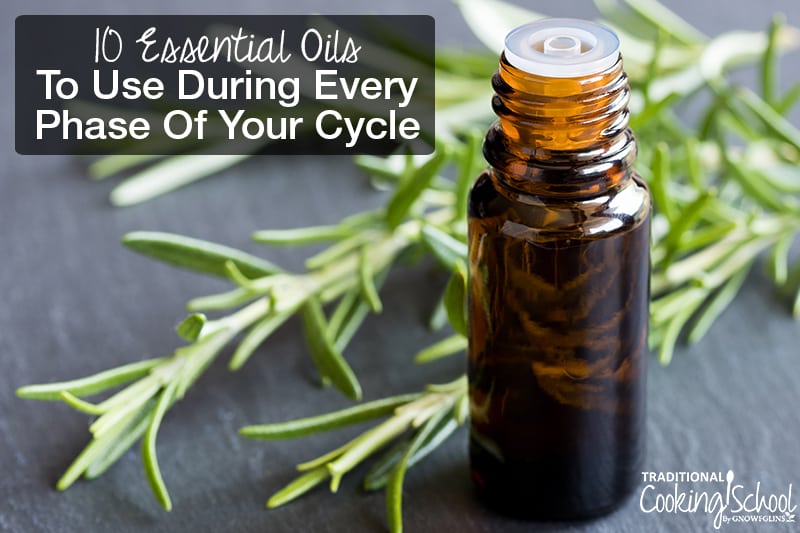
#10 — Rosemary (Rosmarinus officinalis)
Also known as Anthos and Dew of the Sea.
For those moments when you feel stricken with brain fog, rosemary essential oil boosts memory and cognitive function while reducing stress (source)! In fact, people who are exposed to rosemary essential oil are 60 to 75% more likely to remember something than those who aren’t (source).
Rosemary also supports liver function and aids in detox, allowing for proper digestion of nutrients and therefore nourishing our bodies so they can operate smoothly — including during women’s monthly cycles (source).
“There’s rosemary, that’s for remembrance: pray, love, remember.” –Ophelia, from Hamlet
To use: Apply topically if heavily diluted, or diffuse. Consider using before a test or other stressful event to see if it helps, especially if you’re experiencing cycle-related brain fog! Rosemary blends well with peppermint and sandalwood.
Essential Oils For Menstruation
Menstruation marks the beginning of the follicular phase, yet we’ll discuss it on its own. After all, it’s the only part of the follicular phase characterized by bleeding and cramps! Here are some essential oils that can help…
- Cramps: vitex berry, peppermint, clary sage (with lavender and sweet marjoram), fennel
- Heavy bleeding: vitex berry
- General hormone balance: vitex berry, geranium, neroli, clary sage
Essential Oils For The Follicular Phase
Remember, the follicular phase starts with menstruation and ends with ovulation. Estrogen is the dominant hormone during this time, and is responsible for the increased energy and focus that most women feel once menstruation is over. As it rises, cervical mucus gradually starts to thin into the “egg white” consistency of ovulation.
During this phase, you’ll probably be feeling pretty good, so focus on essential oils that promote general well-being and hormone balance as your body gears up for ovulation.
- General hormone balance: vitex berry, geranium, neroli, clary sage
- Bacterial vaginosis: lavender (works well with tea tree)
Essential Oils For Ovulation
As we’re still in the follicular phase, estrogen remains the dominant hormone. It peaks as ovulation approaches. Perhaps surprisingly, testosterone does as well, leading to increased libido. Continue with vitex berry, geranium, clary sage, and neroli essential oils during this time.
Essential Oils For The Luteal Phase (Including PMS)
The luteal phase begins immediately after ovulation and ends just before menstruation. Whereas estrogen quickens, progesterone — the dominant hormone during the luteal phase — quiets. As a result, you may feel more calm and peaceful as the luteal phase begins. Progesterone also thickens cervical mucus once again.
Then, as both progesterone and estrogen taper off in preparation for menstruation, you may start to experience PMS symptoms: bloating, headaches, breast tenderness, etc. Your libido may decrease as well. Here are some essential oils to help:
- Headaches: peppermint, lavender
- Acne: vitex berry
- Cramps: vitex berry, peppermint, clary sage (with lavender and sweet marjoram), fennel
- Bloating/digestion issues: fennel, rosemary
- Brain fog: rosemary
- Insomnia: lavender
- Low libido: ylang ylang
- Anxiety, stress, or depression: orange, lavender, neroli, clary sage
- Low energy/fatigue: peppermint, orange
- Mood swings: geranium
- General hormone balance: vitex berry, geranium, clary sage, neroli
Do you use essential oils during your cycle? Which oils do you use for each phase?
We only recommend products and services we wholeheartedly endorse. This post may contain special links through which we earn a small commission if you make a purchase (though your price is the same).


[email protected]
[email protected]
Haniya: thank you for such an informative article. I want to share the above to addresses m. Jodi Cohen is an amazing woman who creates blends that help people from head to toe and cures her breast cancer with essential oils. She cane from the medical field and works with others to help her clients.
Dr. Mariza also focuses on helping women balance their hormones and take care of their bodies with essential oils.
I haven’t purchased anything from with of them but I do enjoy their articles.
Thank you again. I can’t wait to get my cortisol in order.
Good article. Just wanted to mention that just using the “standard” clary sage, geranium, and ylang-ylang along with evening primrose oil (as a carrier oil and/or suppliments) really has helped my heavy bleeding.
I was told to go on birth control or get a hysterectomy, neither of which did I have peace about; but I prayed and studied, and this natural approach has really helped me.
I have pcos and clary sage indices a period for me each month (I choose)! If I didn’t discover this I would literally NEVER get a period!
Wow, it’s amazing that clary sage does that for you. 🙂 If you haven’t checked it out already, I highly recommend Dr. Lara Briden’s book for information about female health, including PCOS: http://amzn.to/2xWgt0l
Hi, I have a very long follicular phase and I am trying to regulate my cycle for a healthier cycle while ttc. I was going to try vitex berry, geranium and clary stage during the follicular phase up through ovulation. Do you believe that would be best? And do you suggest anything in the luteul phase while ttc? I usually do not have many pms symptoms. Thank you!
Wasabi and horseradish (crucifers) help metabolize estrogen.
Strong, hot parsley tea has long been known to bring on a period.
Stay safe ?
My daughter (11 years old) has had extremely heavy periods for a year which has caused anemia. I have seen 2 Obgyn’s who have said she needs to go on birth control- which I am not comfortable with. I have seen a comment from the 2018 post which mention oils for the same issue my daughter has. I appreciate reading this as I will go this route. Is there any other advice you recommend besides what is mentioned?
Hello. Thank you for the help. I was wondering if there is something to help with hunger after ovulation. I seem to eat 2-3x more to become full after I ovulation ?
Our bodies require about 300 more extra calories in the luteal phase. Make sure they come from fiber filled carbs, lean protein, and healthy fats instead of junk food. We are also more insulin resistant in the luteal phase, so the better we keep our blood sugar balanced, the better we’ll feel.